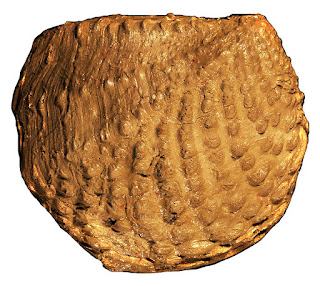This post concerns two species of "knobby" bivalves (clams) of Cretaceous age. They
have medium-sized, sturdy shells with ovate or quadrate shape, and their shells are
ornamented with widely spaced, oblique radial ribs bearing large nodes (knobs). Early workers referred to these kinds of bivalves as "knobby trigoniids."
Both of these knobby genera were partial burrowers, most
likely with one half or less of their shell protruding into the water column.
Their shells were not streamlined enough for rapid nor total burial. For a
time, the sturdy and knobby shells resisted predation by gastropods and fish,
which lived in the nearshore warm-temperate ocean waters preferred by this
bivalve. The predation, however, became too severe (i.e., the Mesozoic Marine
Revolution), and knobby trigoniids went extinct during the Maastrichtian, the
last interval of the Cretaceous.
"Knobby" bivalves, in general, were very diverse during the
Mesozoic. Nearly all of them went extinct at the end of the Cretaceous, most likely because
of over predation by carnivorous gastropods and vertebrates (i.e., the
“Mesozoic Marine Revolution.”) Today, a few relic species related to the "knobby" bivalves survive and live only
in Australia. One of these species is illustrated below.
Exterior and interior views of both valves (left on the left side, etc.) of a modern-day specimen of Neotrigonia margaritacea from southeastern Australia. Notice the "mother-of-pearl" luster on the insides of the valves. The hinge teeth of this small-sized species (2.4 cm height) are stout, long, and fit snuggly inside the sockets of the opposite valve. Neotrigonia margaritacea is a burrower but, unlike most bivalves, it can actually jump.
My post on August 19, 2017 dealt with the morphologic differences between two species of the same genus of a Cretaceous trigoniid. You can always access my previous posts by using the "Search This Blog" box in the upper right-hand side of each posting.
My post on August 19, 2017 dealt with the morphologic differences between two species of the same genus of a Cretaceous trigoniid. You can always access my previous posts by using the "Search This Blog" box in the upper right-hand side of each posting.






No comments:
Post a Comment